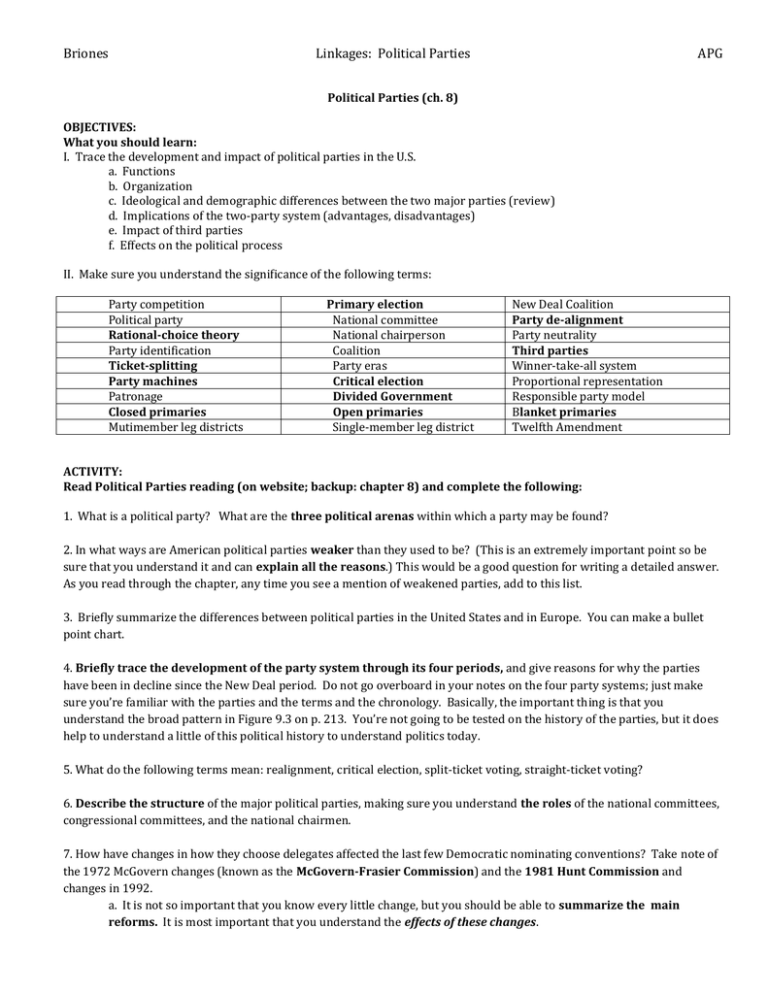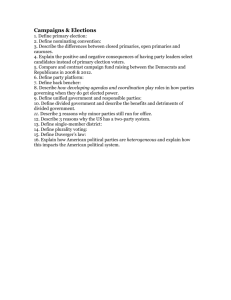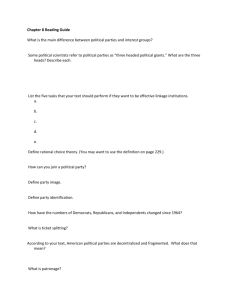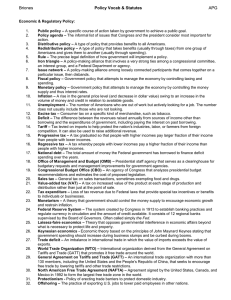BrionesLinkages: Political PartiesAPG Political Parties (ch. 8
advertisement

Briones Linkages: Political Parties APG Political Parties (ch. 8) OBJECTIVES: What you should learn: I. Trace the development and impact of political parties in the U.S. a. Functions b. Organization c. Ideological and demographic differences between the two major parties (review) d. Implications of the two-party system (advantages, disadvantages) e. Impact of third parties f. Effects on the political process II. Make sure you understand the significance of the following terms: Party competition Political party Rational-choice theory Party identification Ticket-splitting Party machines Patronage Closed primaries Mutimember leg districts Primary election National committee National chairperson Coalition Party eras Critical election Divided Government Open primaries Single-member leg district New Deal Coalition Party de-alignment Party neutrality Third parties Winner-take-all system Proportional representation Responsible party model Blanket primaries Twelfth Amendment ACTIVITY: Read Political Parties reading (on website; backup: chapter 8) and complete the following: 1. What is a political party? What are the three political arenas within which a party may be found? 2. In what ways are American political parties weaker than they used to be? (This is an extremely important point so be sure that you understand it and can explain all the reasons.) This would be a good question for writing a detailed answer. As you read through the chapter, any time you see a mention of weakened parties, add to this list. 3. Briefly summarize the differences between political parties in the United States and in Europe. You can make a bullet point chart. 4. Briefly trace the development of the party system through its four periods, and give reasons for why the parties have been in decline since the New Deal period. Do not go overboard in your notes on the four party systems; just make sure you’re familiar with the parties and the terms and the chronology. Basically, the important thing is that you understand the broad pattern in Figure 9.3 on p. 213. You’re not going to be tested on the history of the parties, but it does help to understand a little of this political history to understand politics today. 5. What do the following terms mean: realignment, critical election, split-ticket voting, straight-ticket voting? 6. Describe the structure of the major political parties, making sure you understand the roles of the national committees, congressional committees, and the national chairmen. 7. How have changes in how they choose delegates affected the last few Democratic nominating conventions? Take note of the 1972 McGovern changes (known as the McGovern-Frasier Commission) and the 1981 Hunt Commission and changes in 1992. a. It is not so important that you know every little change, but you should be able to summarize the main reforms. It is most important that you understand the effects of these changes. Briones Linkages: Political Parties APG b. What are superdelegates? c. What are the differences between proportional representation and winner-take-all systems of delegates to the convention? allocating 8. What is a political party machine? How has the power of party machines been weakened? What were some of the positive aspects of party machines? 9. Define and give examples of an ideological party. 10. How does having a personal following reflect a weakened party system? 11. Define plurality system and winner-take-all system. 11. What explanations does the book give for the persistence of the two-party system? 12. Explain why minor parties form, and briefly summarize the different kinds of parties. 13. Analyze why third parties are so rarely successful. 14. Who are the people who turn out to vote in primaries compared to those who vote in the general election?







